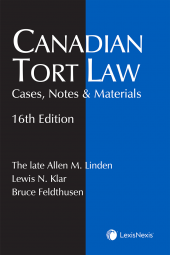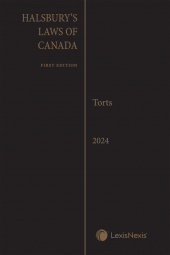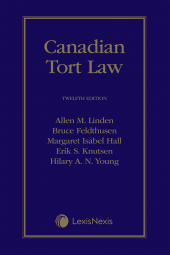Canadian Tort Law – Cases, Notes & Materials, 16th Edition
Designed as an introduction for tort law students, this book offers a probing analysis of basic concepts and an examination of the everyday human problems that this area of law addresses. The authors guide students through this vital aspect of the Canadian judicial tradition.
One Year Subscription Only Terms
Subscribers receive the product(s) listed on the Order Form and any Updates made available during the annual subscription period. Shipping and handling fees are not included in the annual price.
Subscribers are advised of the number of Updates that were made to the particular publication the prior year. The number of Updates may vary due to developments in the law and other publishing issues, but subscribers may use this as a rough estimate of future shipments. Subscribers may call Customer Support at 800-833-9844 for additional information.
Subscribers may cancel this subscription by: calling Customer Support at 800-833-9844; emailing customer.support@lexisnexis.com; or returning the invoice marked 'CANCEL'.
If subscribers cancel within 30 days after the product is ordered or received and return the product at their expense, then they will receive a full credit of the price for the annual subscription.
If subscribers cancel between 31 and 60 days after the invoice date and return the product at their expense, then they will receive a 5/6th credit of the price for the annual subscription. No credit will be given for cancellations more than 60 days after the invoice date. To receive any credit, subscriber must return all product(s) shipped during the year at their expense within the applicable cancellation period listed above.
Product description
Designed as an introduction for tort law students, this book offers a probing analysis of basic concepts and an examination of the everyday human problems that this area of law addresses. The Honourable Allen M. Linden and Professors Lewis N. Klar and Bruce Feldthusen bring to bear a wealth of experience in the classroom and from the bench to guide students through this fundamental aspect of the Canadian judicial tradition.
Features of This Book
- Select extracts of caselaw and articles – present leading examples of judicial opinion, academic thought and competing theories about the value and impact of the law of torts
- Open-ended review questions – provide students with the opportunity to explore and discuss remedies provided to injured parties
- Up-to-date jurisprudence – ensures that students are exposed to the latest trends
What’s New In This Edition
- Updated and reorganized introductory chapter with separate modern rights-based theories, civil recourse theory, and functional approaches including compensation, deterrence, and education
- More emphasis has been given to the important distinction between direct and indirect harm recognized in Canada but not in the UK or USA
- New developments in actions for psychiatric harm are noted as well as the emerging expansion of tort law to govern harassment, public disclosure of private facts, and wrongs like torture and slavery recognized in international law
- Important developments to the law governing duties of care in negligence have emerged following the Supreme Court’s decision in Livent v Deloitte & Touche. In particular, an undertaking by the defendant intended to induce reliance by the plaintiff that was emphasized in Livent has been solidified as the foundation for proximity in negligent misrepresentation, especially in 1688782 Ontario Inc. v. Maple Leaf Foods Inc., 2020 (S.C.C.) and Charlesfort Developments Limited v. Ottawa (City), 2021 (Ont. C.A.)
- A subtle shift by the Supreme Court to a rights-based approach to duty of care in Livent and Maple Leaf Foods is examined, as well as the indirect overruling of Winnipeg Condominium in Maple Leaf Foods. Whether the full novel duty first step duty analysis has become far more likely than the Cooper court probably intended is explored
- The substantial change in British Columbia away from tort law to no-fault insurance for automobile insurance is examined
Who Should Read This Book
- Tort law students seeking an explanation of the latest Canadian laws on torts
- Tort law professors to help assist in teaching Canadian tort law courses
- Tort law practitioners who need a Canadian-focused account of tort law that covers recent changes in the field
- Law libraries looking to expand their legal collection
Table of contents
Chapter 1: Introduction: The Nature and Functions of Tort Law
Chapter 2: Direct and Intentional Interferences with Persons and Property
Chapter 3: Defences to Direct and Intentional Interferences with
Persons and Property
Chapter 4: Negligence: Introduction and Standard of Care
Chapter 5: Proof of Causation
Chapter 6: Duty
Chapter 7: Remoteness: The Scope of Liability
Chapter 8: Defences to the Negligence Action
Chapter 9: Economic Loss
Chapter 10: Tort Liability of Public Authorities
Chapter 11: Strict Liability
Chapter 12: Nuisance
Chapter 13: Occupiers’ Liability
Chapter 14: Business Torts
Chapter 15: Defamation
Chapter 16: Damages
Chapter 17: Future Challenges For Tort Law
 Lexis Nexis
Lexis Nexis 



